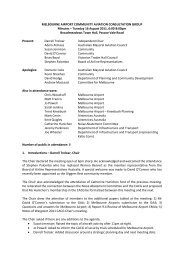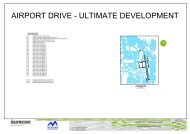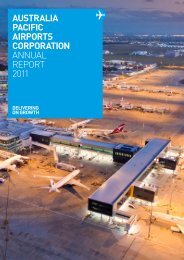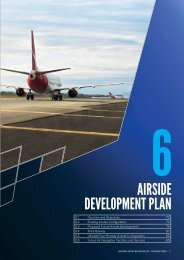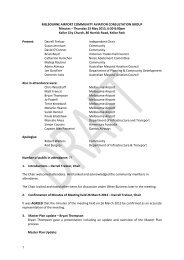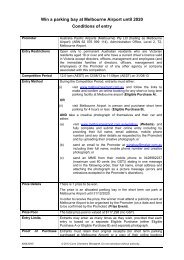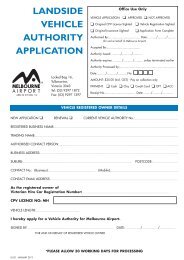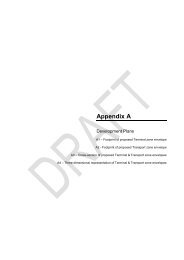Section 9 - Ground Transport Plan - Melbourne Airport
Section 9 - Ground Transport Plan - Melbourne Airport
Section 9 - Ground Transport Plan - Melbourne Airport
Create successful ePaper yourself
Turn your PDF publications into a flip-book with our unique Google optimized e-Paper software.
i. Cycling<br />
In March 2009, the Victorian Government released the<br />
Victorian Cycle Strategy ‘Cycling into the Future 2013–<br />
2023’, an initiative that focused on five strategic directions:<br />
• build networks to connect communities<br />
• promote and encourage a culture of cycling<br />
• reduce conflicts and risks for cyclists<br />
• better integrate cycling with public transport<br />
• integrate cycling into land use planning.<br />
In 2012, the Victorian Government reinforced the same<br />
messages with the Victorian Cycling Action <strong>Plan</strong> 2013–<br />
2014, which also articulated guidelines for growing and<br />
supporting cycling in Victoria.<br />
Cycling access depends primarily on the provision of<br />
safe and convenient bicycle routes and access to quality<br />
end-of-trip facilities (including showers, changing rooms<br />
and secure bicycle parking). It is an important initiative for<br />
thriving metropolitan areas that is sustainable, carries<br />
health benefits and reduces congestion on roads,<br />
all of which are supported by <strong>Melbourne</strong> <strong>Airport</strong>.<br />
However, the aviation industry’s primary focus is not<br />
readily compatible with cycling as a strong transport<br />
alternative. Airline passengers typically carry baggage<br />
and generally travel a considerable distance, which<br />
makes cycling an unrealistic option. Freight and logistics<br />
also derive little benefit.<br />
<strong>Melbourne</strong> <strong>Airport</strong>’s main focus in promoting active<br />
transport is to enable its large workforce to travel to<br />
and from work, particularly those who live close to the<br />
airport and work during daylight hours. This will improve<br />
workforce health and reduce traffic.<br />
In 2002, the Victorian Department of <strong>Transport</strong> released<br />
an updated Principal Bicycle Network (PBN), which<br />
describes existing and proposed on-street and off-street<br />
bicycle networks (refer Map 9.1). The PBN identified<br />
proposed Bicycle Priority Routes that aim to provide<br />
clear bicycle links. Priority Routes to the airport include<br />
Melrose Drive, Centre Road and Marker Road connecting<br />
with the Moonee Ponds Creek Trail (which runs from<br />
Mickleham Road to the airport).<br />
There are currently no continuous bicycle routes from<br />
surrounding suburbs that directly connect with the airport<br />
boundary. On-road bicycle lanes exist along Melrose<br />
Drive in the vicinity of Link Road but do not connect<br />
directly with the airport. While there is an informal route<br />
along the Moonee Ponds Creek Trail that provides access<br />
to the airport, the connections and signage could be<br />
improved to encourage cyclists.<br />
<strong>Melbourne</strong> <strong>Airport</strong> is adjacent to bicycle paths that are part<br />
of <strong>Melbourne</strong>’s PBN, heading to Sunbury, Broadmeadows<br />
and Keilor, where a substantial number of airport staff<br />
members live. The <strong>Airport</strong> Drive extension will provide<br />
paths that will enable a future airport link to the<br />
Maribyrnong path, subject to VicRoads approval.<br />
ii. Walking<br />
The pedestrian environment at <strong>Melbourne</strong> <strong>Airport</strong> is a<br />
critical interchange component between travel modes.<br />
It is important to consider the pedestrian journey as both<br />
employees and passengers must travel from their homes<br />
to terminals and airline gates.<br />
DRAFT<br />
Due to the size and location of the airport precinct and<br />
the presence of major roads and airside operations,<br />
walking to the airport from surrounding suburbs is<br />
considered difficult. As a result, the major pedestrian<br />
concern is facilitating appropriate internal movements.<br />
The airport’s existing walking network consists of internal<br />
footpaths that are provided within the road reserve. Links<br />
between different land uses, such as the multi-level car<br />
park and terminal areas, are provided by elevated<br />
pedestrian bridges where possible to reduce vehicle<br />
and pedestrian conflict.<br />
The major area of pedestrian circulation occurs at the<br />
terminal frontage. This area is a major source of vehicle<br />
activity on Arrival Drive and Departure Drive. Pedestrian<br />
crossing movements that intersect with high vehicle<br />
volumes present safety risks and a potential traffic<br />
congestion concern. In addition, the presence of<br />
uncollected luggage trolleys reduces the available space<br />
for pedestrians waiting on Arrival Drive. The separation of<br />
pedestrians and vehicles continues to be a strong focus,<br />
particularly in the program of improvement/development<br />
of forecourt precincts.<br />
Away from the terminal precincts, the pedestrian network<br />
provides a degree of access to key businesses and<br />
dedicated staff and other car parks. The continued<br />
development of the internal footpath network has been<br />
a recent focus, including improved links along APAC<br />
Drive reinforced by high commercial growth and large<br />
numbers of employees.<br />
112




